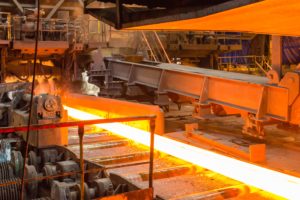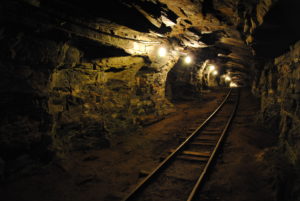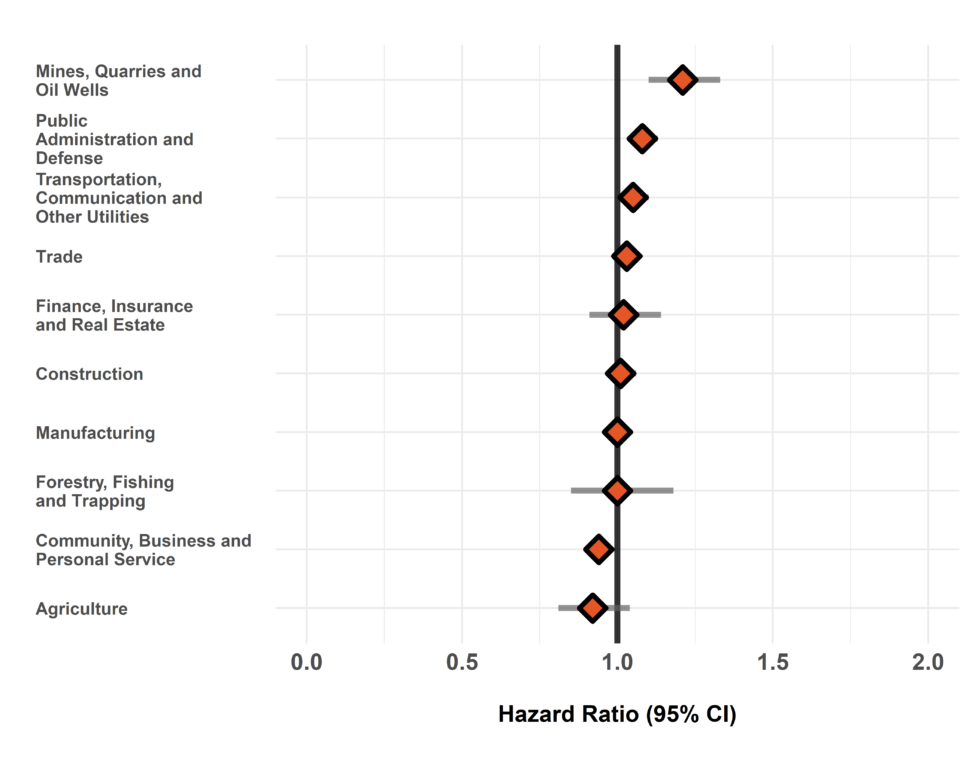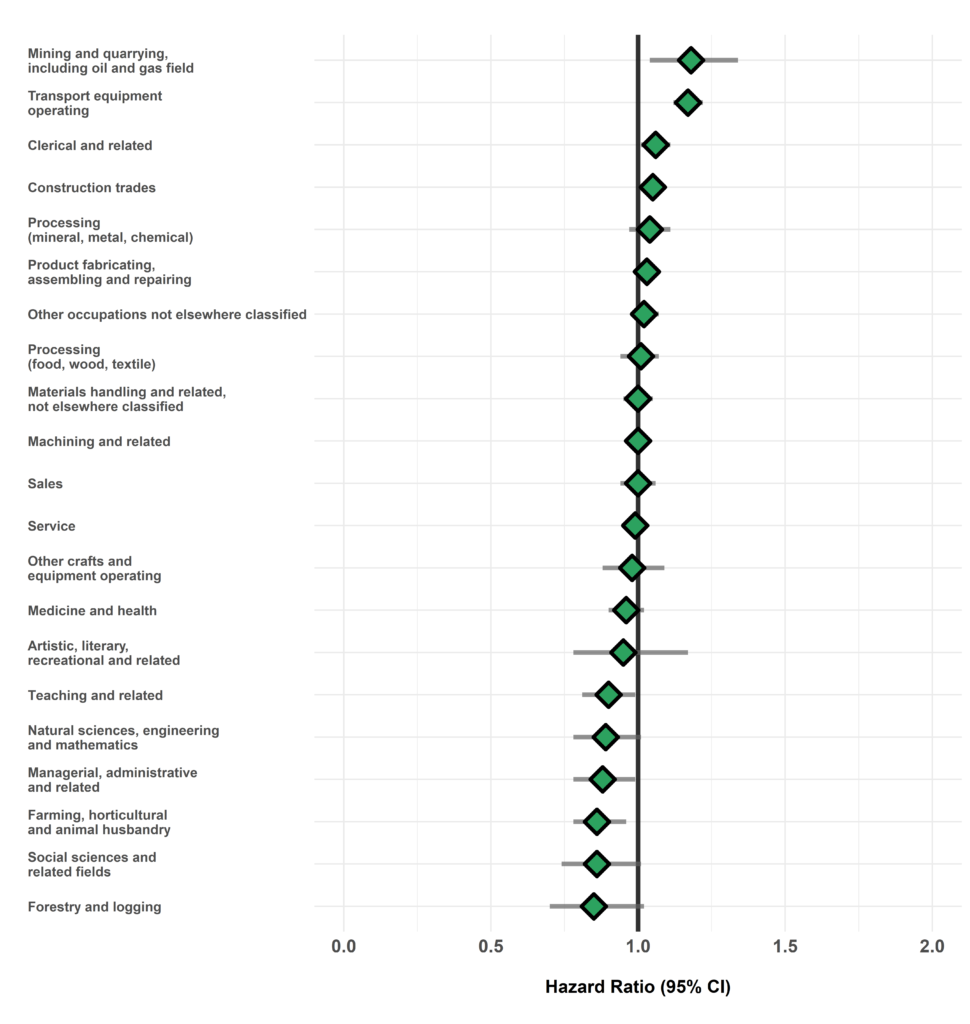Colorectal Cancer
Background
The Canadian Cancer Society estimates that colorectal cancer will be the 3rd most commonly diagnosed cancer in Canada in 2020 [1] . Increased colorectal cancer screening is improving early diagnosis and treatment, but colorectal cancer remains the 2nd leading cause of cancer deaths [1,2]. Colorectal cancer risk is primarily attributed to lifestyle factors including obesity, physical inactivity, poor diet, alcohol consumption and smoking [3]. One study estimated that as many as 11-15% of cases may be attributable to occupational exposures [4]. However, there are no well established occupational risk factors for colorectal cancer.
Possible occupational risk factors
-
- X-radiation, gamma-radiation [5]
- Asbestos [5]
- Night shift work [5]
- Sedentary work [6]
- Diesel engine exhaust [7]
Key Findings
The greatest occupational risks for colorectal cancer in the ODSS appeared to be related to mineral and metal processing, and mining and quarrying. Excess risk was also observed for police officers, firefighters, truck drivers, and bus drivers. Occupational differences in lifestyle factors may play a significant role in the observed occupational differences in colorectal cancer risk. Sedentary work has been posited as a risk factor for colorectal cancer, but no excess risk was observed among most office workers in the ODSS. Non-occupational exposure to ionizing radiation is a risk factor for colorectal cancer. A 13% increased risk was observed among radiological technologists and technicians in the ODSS, but the number of workers employed in occupations and industries with radiation exposure is relatively small.
Mineral and metal processing
Workers in mineral and metal processing may be exposed to a variety of dusts, fumes and other substances, including asbestos, which may contribute to the excess colorectal cancer risk observed.
-
- Metal smelting, converting and refining furnacemen: 1.79 times the risk
- Mineral ore treating occupations: 1.34 times the risk
- Iron and steel mills industry: 1.17 times the risk
Mining and quarrying
Miners may be exposed to ionizing radiation, which could contribute to risk of colorectal cancer. No excess was observed among uranium miners. Protective measures in uranium mines may more effectively protect miners than in other mine types [8]. Additionally, asbestos exposure may be a risk factor among some miners, however, too few cases were observed among asbestos miners in the ODSS to be able to examine this association among miners with the highest risk of exposure.
-
- Mining and quarrying including oil and gas field occupations: 1.18 times the risk
- Blasting occupations: 1.79 times the risk
- Occupations in labouring and other elemental work: 1.42 times the risk
- Other rock and soil-drilling occupations: 1.41 times the risk
- Mines (including milling), quarries and oil wells industries: 1.21 times the risk
- Metal mines: 1.25 times the risk
- Gold quartz mines: 1.25 times the risk
- Miscellaneous metal mines*: 1.34 times the risk
- Uranium mines: no excess risk observed
- Non-metal mines: 1.25 times the risk
- Asbestos mines: too few cases to report
- Quarries and sand pits: 1.28 times the risk
- Metal mines: 1.25 times the risk
- Mining and quarrying including oil and gas field occupations: 1.18 times the risk
*mostly nickel miners
Excavating, grading and paving
Workers in this group may be exposed to diesel engine exhaust, a possible risk factor for colorectal cancer.
-
- Construction: Excavating, grading, paving and related occupations: 1.18 times the risk
- Paving, surfacing, and related occupations: 1.56 times the risk
- Construction: Excavating, grading, paving and related occupations: 1.18 times the risk
Police Officers and Firefighters
Night shift work may be a colorectal cancer risk factor for firefighters and police officers. Firefighters may be exposed to asbestos in older buildings [9,10], which may contribute to the increased colorectal cancer risk observed for this group.
-
- Protective service occupations: 1.21 times the risk
- Firefighting occupations: 1.33 times the risk
- Police officers and detectives, government: 1.32 times the risk
- Protective service occupations: 1.21 times the risk
Transportation
Occupational colorectal risk factors for transportation workers may include sedentary work, night shift work, and exposure to diesel engine exhaust.
-
- Motor transport operating occupations: 1.19 times the risk
- Bus drivers: 1.30 times the risk
- Truck drivers: 1.20 times the risk
- Motor transport operating occupations: 1.19 times the risk
Other groups
Excess risks were observed among several additional occupational groups in the ODSS. The excess risk among service station attendants may be linked to diesel engine exhaust exposure, but occupational colorectal cancer risks among most of these groups is unclear. Occupational differences in smoking may be a factor. Exposure to ionizing radiation is the only known occupational risk factor for colorectal cancer, and a modest increased risk was observed among radiological technologists and technicians in the ODSS, a small group with only 10 cases.
-
- Telephone systems industry: 1.68 times the risk
- Foremen: fabricating, assembling and repairing occupations, textile, fur and leather products: 1.67 times the risk
- Bartenders: 1.44 times the risk
- Service station attendants: 1.38 times the risk
- Radiological technologists and technicians: 1.13 times the risk
Relative Risk by Industry and Occupation
Figure 1. Risk of colorectal cancer diagnosis among workers employed in each industry group relative to all others, Occupational Disease Surveillance System (ODSS), 2006-2016

The hazard ratio is an estimate of the average time to diagnosis among workers in each industry/occupation group divided by that in all others during the study period. Hazard ratios above 1.00 indicate a greater risk of disease in a given group compared to all others. Estimates are adjusted for birth year and sex. The width of the 95% Confidence Interval (CI) is based on the number of cases in each group (more cases narrows the interval).
Figure 2. Risk of colorectal cancer diagnosis among workers employed in each occupation group relative to all others, Occupational Disease Surveillance System (ODSS), 2006-2016

The hazard ratio is an estimate of the average time to diagnosis among workers in each industry/occupation group divided by that in all others during the study period. Hazard ratios above 1.00 indicate a greater risk of disease in a given group compared to all others. Estimates are adjusted for birth year and sex. The width of the 95% Confidence Interval (CI) is based on the number of cases in each group (more cases narrows the interval).
Table of Results
Table 1. Surveillance of colorectal cancer: Number of cases, workers employed, and hazard ratios in each industry (SIC)
| SIC Code * | Industry Group | Number of cases | Number of workers employed | Hazard Ratio (95% CI) † |
| 1 | Agriculture | 270 | 35000 | 0.92 (0.81-1.04) |
| 2/3 | Forestry, Fishing and Trapping |
143 | 10695 | 1.00 (0.85-1.18) |
| 4 | Mines, Quarries and Oil Wells |
469 | 23179 | 1.21 (1.10-1.33)*** |
| 5 | Manufacturing | 8485 | 693317 | 1.00 (0.97-1.03) |
| 6 | Construction | 2346 | 210891 | 1.01 (0.97-1.06) |
| 7 | Transportation, Communication and Other Utilities |
2350 | 197090 | 1.05 (1.01-1.10)* |
| 8 | Trade | 3792 | 429093 | 1.03 (0.99-1.07) |
| 9 | Finance, Insurance and Real Estate |
312 | 23972 | 1.02 (0.91-1.14) |
| 10 | Community, Business and Personal Service |
4993 | 599273 | 0.94 (0.91-0.97)*** |
| 11 | Public Administration and Defense |
2459 | 190800 | 1.08 (1.04-1.13)*** |
| * SIC: Standard Industrial Classification (1970) | ||||
| † Hazard rate in each group relative to all others | ||||
Table 2. Surveillance of colorectal cancer: Number of cases, workers employed, and hazard ratios in each occupation (CCDO) group
| CCDO Code * | Occupation Group | Number of cases | Number of workers employed | Hazard Ratio (95% CI) † |
| 11 | Managerial, administrative and related |
267 | 30976 | 0.88 (0.78-0.99)* |
| 21 | Natural sciences, engineering and mathematics |
242 | 26332 | 0.89 (0.78-1.01) |
| 23 | Social sciences and related fields |
161 | 30700 | 0.86 (0.74-1.01) |
| 25 | Religion | <5 | 128 | — |
| 27 | Teaching and related | 391 | 48454 | 0.90 (0.81-0.99)* |
| 31 | Medicine and health | 1076 | 135268 | 0.96 (0.90-1.02) |
| 33 | Artistic, literary, recreational and related |
94 | 14979 | 0.95 (0.78-1.17) |
| 41 | Clerical and related | 1951 | 197238 | 1.06 (1.01-1.11)* |
| 51 | Sales | 1086 | 148052 | 1.00 (0.94-1.06) |
| 61 | Service | 3639 | 370688 | 0.99 (0.96-1.03) |
| 71 | Farming, horticultural and animal husbandry |
360 | 50126 | 0.86 (0.78-0.96)** |
| 73 | Fishing, hunting, trapping and related |
<5 | 558 | — |
| 75 | Forestry and logging | 113 | 10681 | 0.85 (0.70-1.02) |
| 77 | Mining and quarrying, including oil and gas field |
248 | 13025 | 1.18 (1.04-1.34)** |
| 81 | Processing (mineral, metal, chemical) |
873 | 79195 | 1.04 (0.97-1.11) |
| 82 | Processing (food, wood, textile) |
1007 | 99196 | 1.01 (0.94-1.07) |
| 83 | Machining and related | 2313 | 189346 | 1.00 (0.96-1.04) |
| 85 | Product fabricating, assembling and repairing |
4087 | 328189 | 1.03 (1.00-1.07) |
| 87 | Construction trades | 2784 | 215504 | 1.05 (1.01-1.09)* |
| 91 | Transport equipment operating |
2306 | 168002 | 1.17 (1.12-1.22)*** |
| 93 | Materials handling and related, not elsewhere classified |
1552 | 153012 | 1.00 (0.95-1.05) |
| 95 | Other crafts and equipment operating |
353 | 28290 | 0.98 (0.88-1.09) |
| 99 | Other occupations not elsewhere classified | 2218 | 215187 | 1.02 (0.98-1.07) |
| * CCDO: Canadian Classification Dictionary of Occupations (1971) | ||||
| † Hazard rate in each group relative to all others | ||||
Please note that ODSS results shown here may differ from those previously published or presented. This may occur due to changes in case definitions, methodological approaches, and the ongoing nature of the surveillance cohort.
References
- Brenner DR, Weir HK, Demers AA, Ellison LF, Louzado C, Shaw A, et al. Projected estimates of cancer in Canada in 2020. Can Med Assoc J [Internet]. 2020;192(9):E199–205.
- Colorectal cancer statistics – Canadian Cancer Society [Internet]. [cited 2020 Oct 29].
- Keum NN, Giovannucci E. Global burden of colorectal cancer: emerging trends, risk factors and prevention strategies. Nat Rev Gastroenterol Hepatol [Internet]. Springer US; 2019;16(12):713–32.
- Oddone E, Modonesi C, Gatta G. Occupational exposures and colorectal cancers: A quantitative overview of epidemiological evidence. World J Gastroenterol [Internet]. 2014;20(35):12431–44.
- IARC Working Group. List of Classifications by cancer sites with sufficient or limited evidence in humans, Volumes 1 to 113 [Internet]. Lyon, France: International Agency for Research on Cancer (IARC);
- Cong YJ, Gan Y, Sun HL, Deng J, Cao SY, Xu X, et al. Association of sedentary behaviour with colon and rectal cancer: A meta-analysis of observational studies. Br J Cancer [Internet]. 2014;110(3):817–26.
- Kachuri L, Villeneuve PJ, Parent MÉ, Johnson KC, Harris SA. Workplace exposure to diesel and gasoline engine exhausts and the risk of colorectal cancer in Canadian men. Environ Heal A Glob Access Sci Source [Internet]. Environmental Health; 2016;15(1):1–12.
- Canadian Nuclear Safety Commission. Uranium mines and mills [Internet]. [cited 2020 Oct 29].
- Ramsden R, Smith J, Turcotte K, Garis L, Kunz K, Maxim P, et al. Determinants of Injury and Death in Canadian Firefighters A Case for a National Firefighter Wellness Surveillance System [Internet]. Abbotsford, British Columbia; 2018.
- Markowitz SB, Garibaldi K, Lilis R, Landrigan PJ. Asbestos Exposure and Fire Fighting. Ann N Y Acad Sci. 1991;643(1):573–7.
